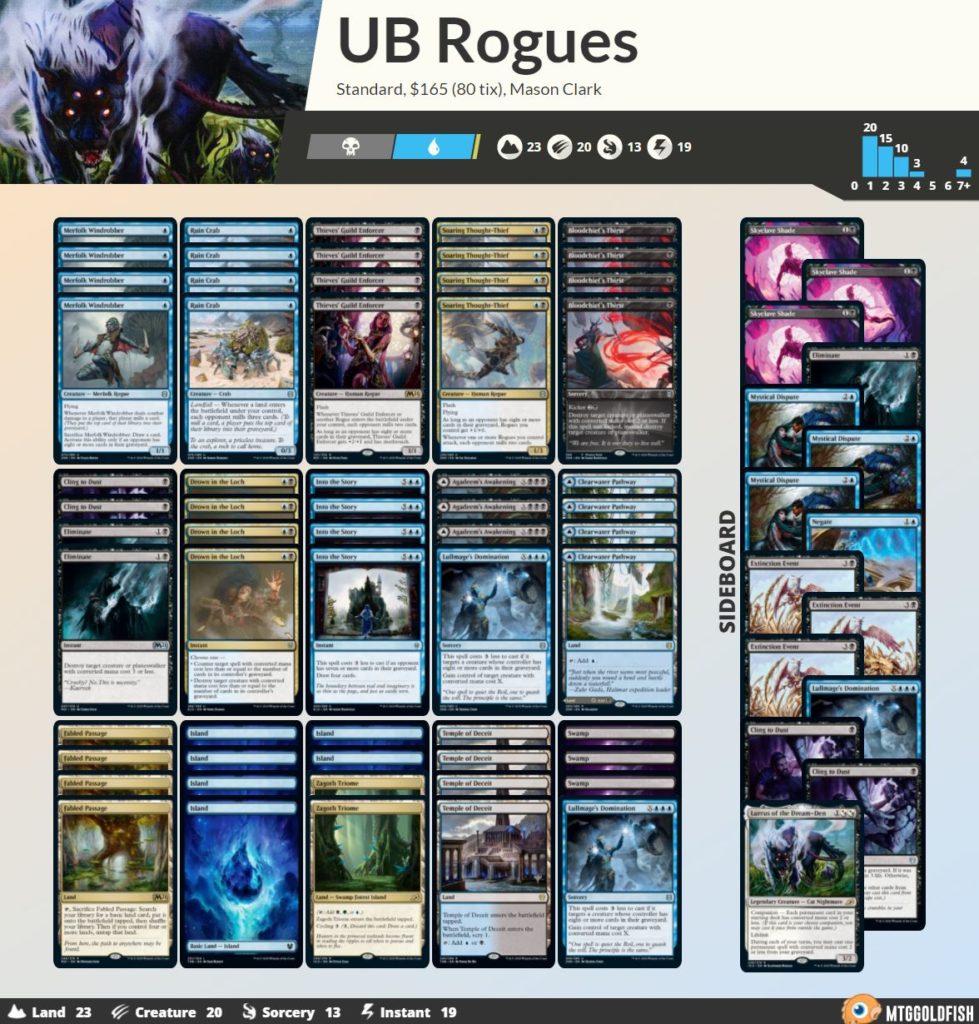I recently heard a story that I’ve been thinking about a lot. A Magic player was once talking to Brad Nelson, and they asked him for advice on how to improve their game. This player was playing the stock best deck with all the best cards on rate, but they still weren’t getting the results they wanted.
Here’s the advice Brad offered: “You should play a few less cards like Siege Rhino and a few more cards like Abzan Charm.” He went on to say that having more solid, flexible cards gives you more game against much better players. The best players in the world are very used to playing against the stock stuff, he said.
This was an interesting story to me because, in some ways, it contradicted my experiences playing Magic. Recently, I’ve stopped playing “cute” decks with “cute” cards and making sure to always play solid decks instead — much like the player in the story. Was it possible that I was misevaluating too many cards, seeing them as “too cute” instead of “flexible but strong”?

Abzan Charm is the perfect example of this kind of card. It doesn’t blow any minds when you read it; it’s either a pump spell, a Sign in Blood, or a conditional removal spell — all of which are fine, but not worth three different colors of mana. Yet that card is still strong. It doesn’t ask much of you thanks to its ability to always draw cards, and it really opens the doors on some plays. Maybe you’re able to attack your Siege Rhino into their Siege Rhinos? A great player who has seen the Charm might play around it, but if they haven’t, they’ll run straight into the pump spell part of the card.
This idea of playing flexible cards is relevant to today’s Standard metagame — especially if you’re playing Rogues. Rogues has always been a fine choice at worst in this Standard format, with weekends of greatness. One reason for this is that the deck is full of good cards, most of which have a lot of play to them.

Just look at Thieves’ Guild Enforcer. It may look like a straightforward card at first, but the more you play with it, the more you realize it can do.
Here are just a few things Thieves’ Guild Enforcer can do in Rogues:
- Present early pressure
- Flash threat to change races
- Graveyard enabler
- Ruin opponents’ scrys
- Block and trade with a larger creature
- Backup play on turns you’re holding up other spells
- Flash play from the graveyard off Lurrus
And that’s just one card in the deck!
Rogues is full of flexible cards like this, and that’s what has made it one of the best decks to play over a long period of time. While it might have some weeks that are better than others, this consistent and powerful deck is one that will always give you options.
There are some cards that have become stock in Rogues decks, regardless of what build you’re playing. Thieves’ Guild Enforcer, Soaring Thought-Thief, Into the Story, and Drown in the Loch are non-negotiable and make up a lot of the power in these archetypes. While other cards bring a lot to the table, this “core” will be what brings a lot of the wins.
I could go on about what makes all these cards great, but that’s not what we’re here to talk about today. Instead, I want to focus on the cards you should be playing in your Rogues list this week — or the cards to anticipate from Rogues players. Here’s the decklist I’m currently working with this week, along with a list of seven cards I recommend you try in Rogues. While this might not be the exact 75 I end up playing in the SCG Satellite this weekend (follow me on Twitter @masoneclark to see my final decklist 😉), I hope this will give you some insight into Rogues decks and hopefully help inform your own card choices.

Buy this deck from Card Kingdom
Export this deck to Arena via MTGGoldfish
Main Deck Cards
Lurrus of the Dream-Den

First off, I’m choosing to play a Lurrus build of Rogues. This prevents me from playing cards like Zareth San, Gadwick, and Shark Typhoon, to name a few. While those are strong cards that all have places in the metagame, I feel the flexibility and resiliency that Lurrus brings is vital right now. It’s also worth noting that you can include any number of these higher mana cost cards in your sideboard; the trade-off is losing access to Lurrus in the companion zone for Games 2 and 3.
Ruin Crab

At first, I was a Crab denier. I was always trying to cut one from the main deck or play it in the sideboard. Then, after playing the deck and refining my build with cards like Lullmage’s Domination in the main deck, I came to the conclusion that you just have to play the full four main. It’s an enabler card in most games, but its potential to steal a game is very high. You will often trim a few post-board, given that games will go longer, but it’s too powerful and too important at turning our key cards on to cut from the main deck.
Eliminate

I prefer this card over Heartless Act, for the most part. There are actually a fair amount of creatures you want to kill in the early game that can get a counter on them, and Heartless Act just folds to them. Given that our deck makes the game go fairly long, I’m averse to having cards with a higher chance of losing effectiveness as the game goes on. Cards like Scavenging Ooze come to mind: in the early game, it’s very easy to put a single counter on it, and in the late game, it’s a must-answer threat that we can struggle to address. When cards like that are as highly played as they are, I’m willing to give up some raw power to make sure the job is taken care of.
Lullmage’s Domination

This is a card you see a lot of in Rogues sideboards. I’ve moved mine to the main simply because of how powerful this effect is in the current metagame. Every deck has a creature you want to steal and get out of the way, and Domination is also an unreasonably powerful tempo play. You can effectively undo your opponent’s and shift the power to your side of the board, and that’s good in every single match-up (including Yorion, where the 4/5 is often very effective at holding you back).
This also serves to win the mirrors in Game 1. The mirror is often about board presence; you want to force your opponent to answer your board while you refuel with cards like Into the Story. This card allows you to undo their work while accelerating your own game plan.
Cling to Dust

I play two copies of Cling to Dust in my main deck so I always have a way to use any extra mana I have lying around. It’s also a great way to regain life, and this deck can often fall behind a bit in that regard. There are also many decks that make use of cards in the graveyard, like Mono-Green Food; they often rely on a Feasting Troll King to beat you in combination with Trail of Crumbs. Cling cleanly answers cards like this, and it’s useful in pretty much any match-up. Rogues has a lot of Abzan Charms in it, but if I had to pick one card that exemplifies flexibility, it’s Cling to Dust.
Bonus: 23 Lands (26 with Agadeem’s Awakening)

Before we get into sideboard cards, I want to highlight something important. I’ve seen people start cutting a land from Rogues, and I have to recommend against that. You want to curve out every game and always be casting your spells. As such, I would rather err on the side of playing too many lands than too few. You have huge refuel cards like Into the Story and Agadeem’s Awakening in this deck, so you want to be curving out and maximizing on mana. It might seem nit-picky, but I firmly believe you need at least 23 lands in this deck.
Sideboard Cards
Skyclave Shade

This is a card that I personally don’t love too much, but it serves its purpose. In grindy match-ups like the mirror, it’s a repeatable form of card advantage that puts pressure on the opponent; against decks like Esper Doom, it does a similar job while also completely invalidating Doom Foretold. These are the two biggest reasons why I have three in my board. I’m hesitant to put a card like this as a full four-of in my sideboard — it’s narrow, and the opportunity cost of adding another card in the sideboard is too high — but it can be a real headache for your opponents.
Extinction Event

This is a card that I’ve been incredibly happy with in every top match-up. (Yes, even Esper Doom — Archon of Sun’s Grace is backbreaking!) I often bring some number of this card in for every match-up: one for Rogues, two for Esper, three for Gruul. It’s the type of card that allows for you to completely swing the tide of the game, and this deck often has the ability to make it a one-sided wrath. Rogues primarily consists of odd-costed creatures; with Event in hand, you can answer your opponents’ odd-costed cards before adding to your board so you can set up a one-sided board wipe in the later turns.
There’s another lesson here I wanted to quickly highlight. Just because you see three copies of a card like Extinction Event in a sideboard doesn’t mean you have to bring in all three copies in every match-up. It might be good enough to justify bringing the card in, but making sure you don’t over-sideboard is critical, especially if you can envision a scenario in the match-up where the card might not be good.
That’s going to do it for this round-up of cards to play in Rogues. Rogues is a deck with a low floor, but a very high ceiling; your cards are strong and flexible and can lead to lots of interesting games. If you start playing the deck now, your time and investment into it will compound. It’s always been a reasonable choice in this metagame, and it seems that won’t be changing anytime soon.
Have a tech card you really love in Rogues? Tweet at @masoneclark and @card_kingdom and let us know!

Mason Clark is a grinder in every corner of the game who has played at the pro level and on the SCG Tour with Team Nova. Whether he’s competing in Standard, Historic or Modern, Mason plays with one goal in mind: to be a better player than he was the day before. Check out his podcast, Constructed Criticism, and catch his streams on Twitch.

